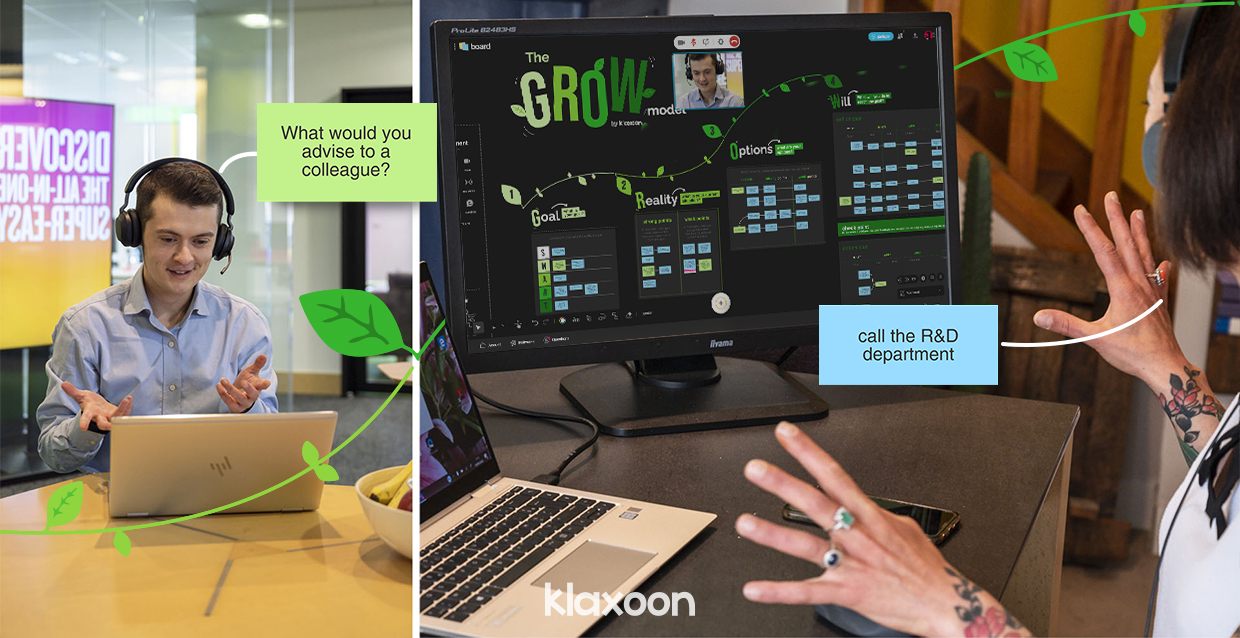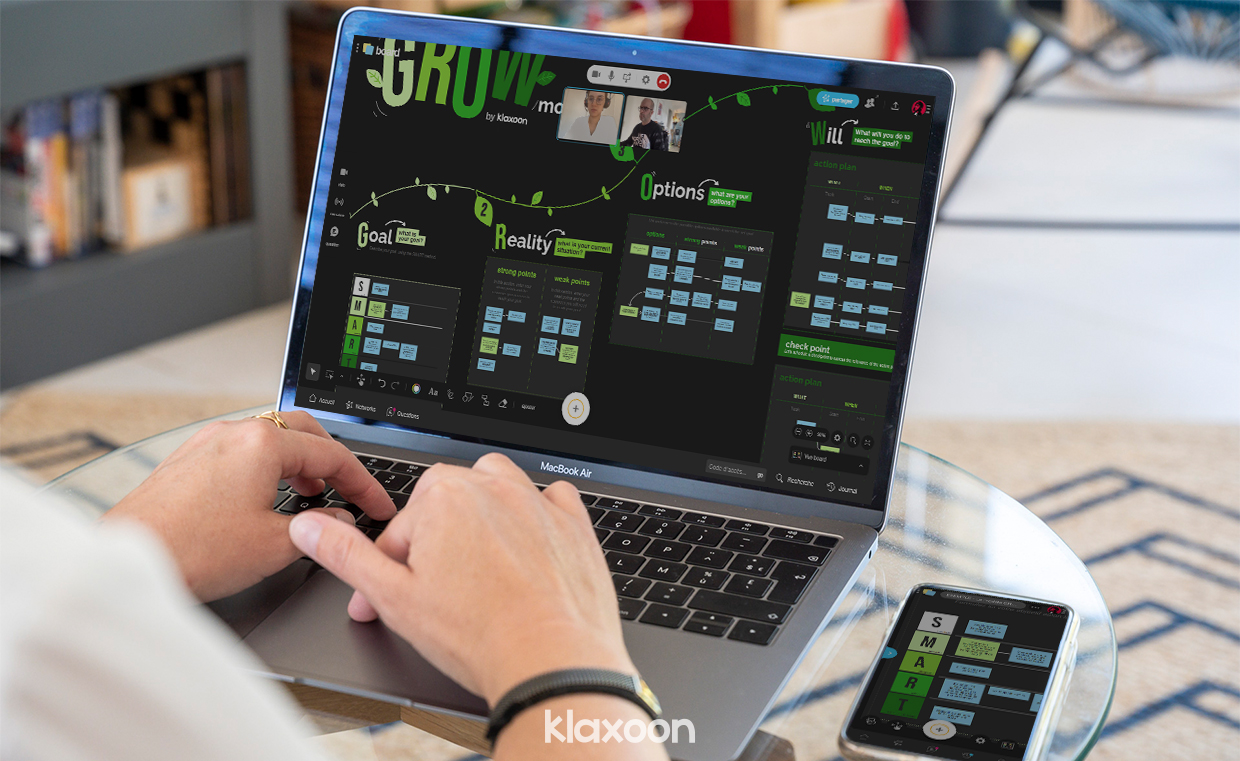The GROW Coaching Model for Improving Employee Engagement
Published on February 14, 2025
The GROW Coaching Model for Improving Employee Engagement


In the world of business like in the world of sport, a team’s success depends very much on individual engagement. It’s therefore vital for managers to be able to coach every single member of their team as effectively as possible. Follow the GROW model’s four simple and effective stages to increase employee engagement and help each and every one achieve their goals!
As the name indicates, the GROW coaching model is an ideal framework to increase employee engagement, and help team members make progress and achieve their goals. It consists of four successive easy-to-remember steps represented by their initials:
The GROW model was designed in the nineteen-eighties by three business coaches: Graham Alexander, Sir John Whitmore and Alan Fine.
They designed the model so that managers and leaders could help individual employees achieve their full potential. Every manager knows that one of their key tasks is to help each member of their team to move forward so that the whole team can reach new heights and increase their performance!


A manager and team member using the GROW coaching model remotely
The GROW model is an easy-to-use coaching framework. This structured method is all about showing empathy and listening to your team members so they can achieve their set goal.
Follow the four key steps in GROW coaching : G-oals, R-eality, O-ptions and W-ill.
Clarify what the coaching session is to achieve by exploring the team member’s needs. For instance, ask questions about what they are hoping to improve, what obstacles they need to overcome and what they hope to achieve. Finally, make sure that your team member’s goal complies with the SMART method principles.
Building on the ideas put forward by their manager, the team member, the coachee, defines their goal, using the SMART method, and makes sure that the objective is:
Clarify what the team member has already achieved and identify any obstacles preventing further progress. Ask exploratory questions to encourage them to provide as much information as possible on their present situation. Let them carry out a self-assessment before volunteering your own opinion.
The team member is expected to assess their own personal “state of play” as it stands, with its strengths, weaknesses, resources available and further resources required. This is like defining a starting point leading up to the set goal.
Ask exploratory questions to encourage the team member to make a critical assessment of possible solutions. For instance, ask for the team member’s impressions on each of the possible options, what other options are available and what they would advise a colleague to do in this situation.
The team member will try to imagine, define and assess the solutions available to achieve the set goal, given the state of play. They should weigh up the pros and cons, and pick the best solution(s).
Ask your team member to explain how they intend to reach the set goal. Using the Question activity, agree together on a progress assessment date. If progress falls below expectations, you can then advise them on adjustments they need to implement to reach the goal.
The team member uses the options defined in the previous stage to imagine one or several actions required and to define a detailed action plan in the dedicated space.


Each step of the GROW model is easily realized thanks to the Klaxoon Template
You are now ready to launch a coaching session for each of your team members! Even though the GROW model is specifically adapted for one-to-one monitoring, it can also be used for group coaching sessions.
This off-the-shelf Klaxoon model is available in our template library, and can be used by you and your team member to apply the four GROW model stages interactively.
It is your responsibility, as the coach, to act as a guide and put your team member on the right track. You can help them with open questions, by listening closely to what they have to say and by showing empathy. Make sure your feedback is helpful, by providing your take on the issue without telling them what to do.
The team member being coached should imagine their own approach to the problem and set up milestones to achieving the goal.
The GROW coaching model improves team member engagement and reinforces the team spirit. It promotes confidence, motivation, leading to increased performance and personal satisfaction to the coachee.
Home working doesn’t necessarily mean fewer contacts between managers and team members… Klaxoon’s Board can bring people closer together than ever! This digital whiteboard is a powerful communication tool where documents and ideas can easily be shared. In practice, this means that a team member can share with you in writing any idea that comes into their head, via their smartphone, tablet or computer. The idea then becomes a colored thumbnail that can be moved across the Board at any time.
You can also add images and sound to the idea as the need arises. You can also enable the Live videoconferencing feature to speak to and see each other in real time, as if you were in the same room. So Board sets up ideal conditions for coaching sessions, both in person or online!
For managers, the GROW model is an easy-to-use tool for employee engagement support. All you need to do is set up a dedicate Board for each member! These individual Boards can then become individual logbooks where you can add as many GROW coaching session narratives as you like. This allows both you, the manager, and your team members to monitor their progress in the company over the years through the goals they have set and achieved.
The Board therefore becomes a forum where your team members can describe and achieve their goals. It also records their achievements and performances, which helps to boost trust and morale within the firm.
Sessions can vary in length according to the coaching session goals:
You may also have difficulty coordinating sessions with your team member, especially if you have a very busy schedule or work in a different time zone.
With Board, you can coach your team member just as effectively, anywhere and at any time. Board means that users can work separately at their own speed. You put questions to team members in writing or by sharing an audio or video file and they can answer as soon as they are able to do so. It can also work both ways so the GROW coaching session can develop gradually through its four stages. Both you and your team members will be aware of what is happening on the Board thanks to the Journal notifications. It's easier for you to provide them with guidance every step of the way!


The coaching session develops with everyone working at their own pace.
Get inspired by other templates from the same categories
Unlock your teamwork potential